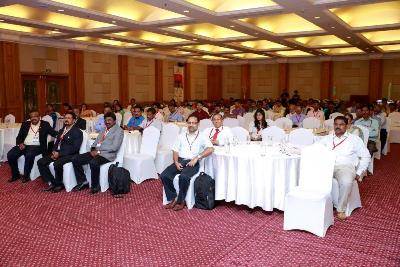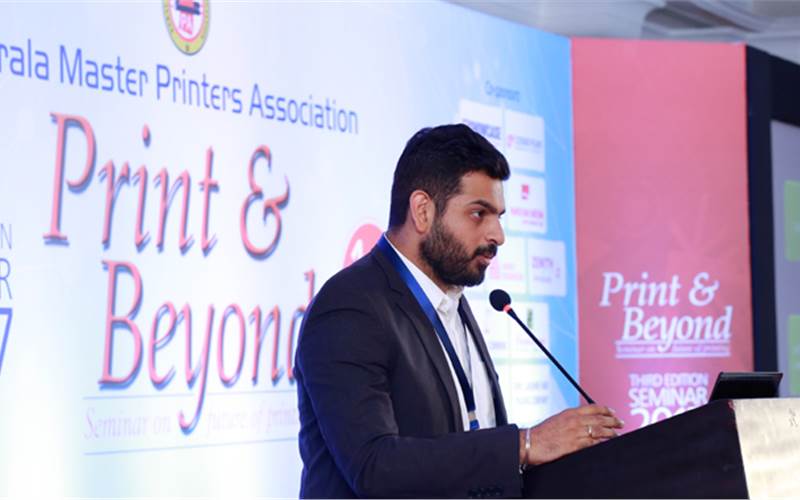The four pillars of packaging by Ankit Tanna of Printmann Group
Industry leaders come together to discuss the industry scenarios during the KMPA”s Print and Beyond seminar held in Kochi, Kerala on 13 January 2017.
30 Jan 2017 | By PrintWeek India
Ankit Tanna, director of Printmann Group, who specialise in four verticals: cartons, leaflets (which includes inserts, medi-guides and outserts (for the US Market), self-adhesive labels on bottles and most recently aluminium foil which is blister and strip packs. Ankit Tanna who has served the organisation for seven years, spoke about how a mid-sized firm could make a transition to packaging. He said, “The ROI on quality is goodwill and customer satisfaction.”
Tanna said, “In 1987, we had a small, humble beginning started with commercial printing for FMCG companies and marketing jobs of pharmaceutical companies. In 1989 we diversified into pre-press where we had imagesetters and drum scanners for the proofs. This was before the CTPs came in. In 1993 considering the cutthroat competition among FMCG companies, Bipin Tanna (Ankit's father and founder of the company) wanted to diversify. At that time our pharma clients were seeking someone with our level of quality to supply to their packaging needs. So that’s how Printmann forayed got into packaging.”

Ankit Tanna has summarised his learnings into the four pillars of packaging. These pillars are “a must for a successful packaging company”.
Quality
Quality packaging or no packaging is of the prime importance. For us, this holds true every day because it was the appreciation of our quality which gave us a genuine opportunity in packaging.
It is a clear differentiator. It's not price, its quality which will be a differentiator in packaging. Because unlike commercial printing where you are printing marketing material, in packaging, you are printing their raw material. You are representing their brand, their identity. Therefore there should be no compromise.
In the packaging industry, a lot of your clients will demand certifications. Today the carton, label and leaflet division of Printmann group is an ISO 9001:2008, PS 9000 and a BRC:IOP certified plant. The foils division is an ISO 15378 Plant with USDMF certification. Often we ask ourselves and discuss with our peers as to who is going to pay for all these costs related to the certifications. The truth is no one. But we must realise that these certifications must be done for ourselves more than doing it for the client. These certifications create a system which takes me to the next point.
Systems must work, not the people. If systems are in place, people will have to follow; since they will have a roadmap laid in front of them. Because as a business owner, you cannot ensure quality during every process.
In packaging, you will often face audits wherein the auditors check the inspection systems in your processes. These online inspection systems come at a high price. But when you see your cost sheet there is no charge for inspection systems or quality control. That is a given.
This takes me to the next point. Quality systems and implementation should not be considered as a cost but an investment. But the question you will pose is, what is the ROI ? The intangible ROI is Goodwill and Loyalty.
Your clients will stay with you because your inspection systems will make the product work seamlessly on your cosutomer’s lines and hence give your customer a good night’s sleep. The tangible ROI is obvious: getting rid of labour complexities.
Work culture
Quality is going to be redundant if a packaging firm is not successful in changing or implementing the workculture of the organisation.
Back in Mumbai, we say ‘get rid of the Chalta hai" attitude which means I know it's not up to the mark but it is almost perfect!! In packaging, the world is binary. It is either okay or not okay. That change in attitude has to trickle down from you all the way to the helper on your machine.
In commercial printing, you will be told to use CMYK with lamination. In packaging you will be instructed “185c red, reflex blue and 376c green with benzphenone free varnish and braille height of not less than 1.6mm”. Firstly, as a business owner, you must understand why this is important. Imagine a Colgate red or Bank of Baroda orange. These brands are defined by the colour on the packaging. So we must respect these colours. This mathematical reading of numbers to define colours must percolate to the operator. That is the change in culture, that packaging seeks.
In packaging you will come across migration issues. This means, the inks and varnish you are using should not migrate into the clients product. Let's be clear if the client demands it, he must pay for it. And if he is paying for it, we as packaging solution providers must implement it. If the client is not ready to pay we must refuse to use that varnish because that’s where our responsibility lies. Imagine this scenario, a cereal box in which we were told to use a particular food grade varnish. For some reason, you didn’t. Now that box lands into your kitchen for your child's breakfast. Scary?
That is the responsibility a packaging unit must have in its culture. At Printmann, we are into pharmaceutical packaging and we keep telling our helper that if you don’t use the product mentioned in the job card or do not follow the system, then someone's life is at stake.
Trainings help in continuous improvement. Internal audits help in identifying the loopholes which disrupt the system.
And finally EHS has to be a cultural change of top management. Fire audits, fire marshalls, first aid audit, medical checkups, colour blindness tests. All these are very important.
Customer service
Packaging is a complex process. Take a carton for example. You convert the PDF received from a 2D blueprint to a 3D carton. It involves the entire pre-press process, die-making, etc. This is followed by the printing and then die cutting; followed by braille and pasting. How will your client know the pains you go through until he sees it first-hand? Therefore invite the client over. Make him understand your processes. If he sees it, he will believe the lead time you require and the price you are quoting.
Educate the client. Because if you don’t, someone else will. Discuss your costs openly, and don’t try to bluff him.
Also simultaneously keep listening to your client. Try to follow their path. If you see they are successful, then you can grow with them.
Never lose respect, printers have this huge respect deficit.
As a community, we must work towards reducing the trust deficit. We must reach a point where we are seen as partners and not just vendors
Innovation and R&D
At Printmann we treat innovation as part of our customer service. It is my duty to come up with new products or tweak processes to better my services. But how does one innovate? After all, innovation is quite a subjective thing. It means different things for the people in the value chain. It can be very different for someone at the brand end of the packaging sector to someone at the technical end.
Therefore stay in touch with your clients product / packaging development team. There will be no need for an idea generation at your end. All of you have to do, is listen to their concepts and then you need to execute it with your R&D.
Secondly, visit or participate in your industry and your client's exhibitions to study the trends. It is crucial to know what the techniques, materials and technology relating to print for the packaging sector. Also, it is a good time to pick the brains of the decision-makers about things like green eco-friendly packaging and understanding how they do their filling, packing, fulfilment and logistics services.
Third, walk into a supermarket to see the packaging available in the market. Compare them to your products. Strip open the carton and challenge yourself to make it better. Look at the embellishment. An important area for producing value-added products is in special finishes. This is where the demand is on the up. It depends on the sector but we are seeing a lot more use of embellishments, such as foiling, by brands that are differentiating their products. With extra finishes come at an extra cost, and as such, the mindset of the brand owner is crucial. While some customers are focused solely on price, others are more open to the potential sales uplift that a slightly higher spend on a fancier packaging can deliver.
Printing is a means to product creation
Before I end I would like to quote a line in the invite of today's seminar that ‘Printing is a means to product creation’. I agree. I say, always respect the product creation/value addition you are doing. You are converting a mere piece of paper into a beautiful carton which is going to enhance your customers brand. The day you start respecting this credo, is the day your clients will respect your work and you.
Printmann: At a glance
Turnover: Rs 80 crore INR
Deemed exports: 80% of turnover
Employees: 350
Locations: Mumbai, Navi-Mumbai, Vasai
Focus: Pharmaceutical packaging specialist – folding cartons, inserts and outserts, labels and aluminum foils.














 See All
See All